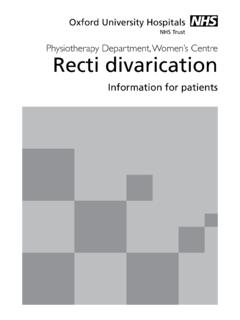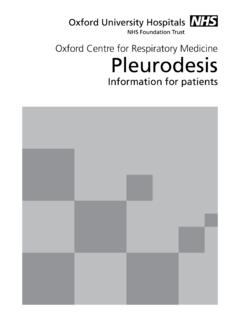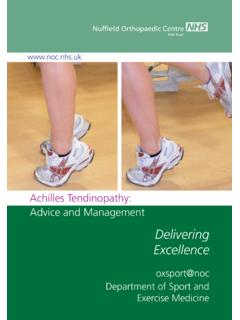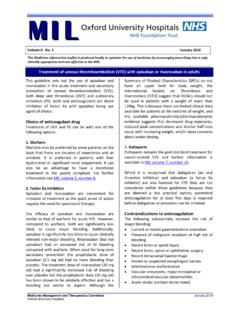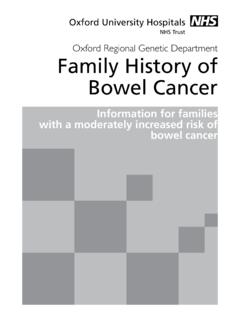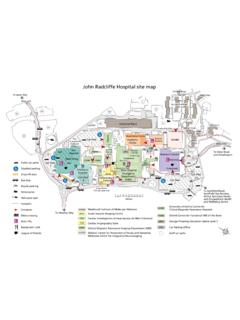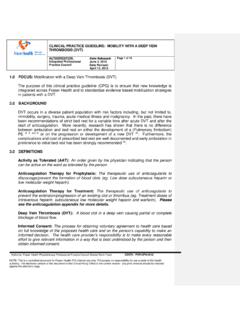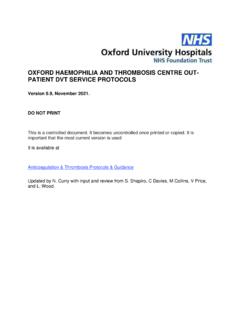Transcription of NHS Trust Sentinel lymph node biopsy and wide local excision
1 Oxford University HospitalsNHS TrustSentinel lymph node biopsy and wide local excisionInformation for patientspage 2 IntroductionThis booklet has been written to give you information about having a Sentinel lymph node biopsy . It has been compiled by experienced staff, as well as patients, and answers the most frequently asked information is a guide only. Your healthcare team will give you more detailed information as you need it. They are also happy to answer any questions and address any concerns you may have. We hope that you and your family will find this information both reassuring and is a lymph node?A lymph node is part of the body s lymphatic system. The lymphatic system is a network of vessels that carry a clear fluid called lymph around the body.
2 lymph vessels lead to lymph nodes. lymph nodes are small, round organs that trap cancer cells, bacteria, or other harmful substances that may be in the lymph . Groups of lymph nodes are found in the neck, armpits (axilla), groin (inguinal), chest and is a Sentinel lymph node?The Sentinel lymph node (SLN) is the first lymph node to which cancer is likely to spread from the primary skin cancer (melanoma). Cancer cells travel to the Sentinel node before spreading to other lymph nodes. In some cases there may be more than one Sentinel node. The Sentinel node is usually found in the armpit (axilla), the groin (inguinal), or the neck, depending on where your melanoma was removed do cancers spread?Skin cancers such as melanoma and squamous cell have the ability to spread to other parts of the body; these are called metastases or secondaries.
3 Cancers spread in different ways. The majority of skin cancers spread via the lymph system. If the cancer has been caught by a lymph node it can grow and multiply within the node. In time it can spread to the next node down the chain and so 3 Cancers can also spread to other parts of the body in the blood stream. These can be detected by CT (Computerised Tomography) scans of your is a Sentinel lymph node biopsy ?SLN biopsy is a procedure in which the Sentinel lymph node is removed. It is then examined under a microscope to determine whether it contains any cancer cells. This shows whether melanoma cells have moved from the original melanoma into your lymphatic system. SLN biopsy is based on the idea that cancer cells spread (metastasise) in an orderly way, from the primary skin cancer to the Sentinel lymph node(s), then on to other nearby lymph nodes A negative SLN biopsy result suggests that the cancer has not spread to the lymph nodes.
4 A positive result indicates that cancer is present in the SLN and may be present in other lymph nodes in the same area (regional lymph nodes). This information will help your doctor to work out the stage of the cancer (extent of the disease within your body) and to develop an appropriate treatment plan. The operation is performed under general anaesthetic, which means you will be asleep throughout. You may be able to go home on the same day or may need to stay in hospital will happen before the operation?We will ask you to come to the pre-operative assessment clinic. At this appointment, the nurse will check your weight and blood pressure. We will also ask you about your medical history and any medications that you may be taking. You will have blood tests and may also have an ECG (electrocardiogram) to measure the activity of your heart as well as a chest X-ray.
5 On the day before or the morning of your operation you will need to have a lymphoscintogram. This is a type of scan that shows where the lymph from the patch of skin containing the melanoma would drain to. The scan does not tell us that the melanoma has spread, just the path it would take if it had spread. page 4 What happens during the lymphoscintogram?This scan is carried out in the nuclear medicine department at the John Radcliffe Hospital. The radiographer (specialist in X-rays and scans) will explain the process to you in greater the scan, we will put some anaesthetic cream around your melanoma scar and will cover it with a dressing. This will be done a short while before the scan and will numb the area around your melanoma the area is numb, a small amount of radioactive liquid will be injected around your melanoma scar.
6 You will be asked to lie still for 15 minutes and then the scan will be taken. You may be asked to change position for different views of your scar. You may also be asked to return to the waiting room and walk around for up to an hour to encourage uptake of the radioactive liquid by the lymph node. Further scans will then be taken. The position of what are called the hot node(s) that have taken up the most of the radioactive liquid will be marked on your skin. Please do not wash this mark day of your operationOn the day of your operation you will need to come to the ward where you will be admitted by the nurse. Please remember to follow any instructions on when to stop eating and drinking. These instructions will have been given to you at your pre-operative assessment anaesthetist (the specialist doctor who gives you the anaesthetic that sends you to sleep) will see you and explain the anaesthetic to you.
7 Your surgeon will also come to see you to go over the details of the operation and the risks and benefits. Your surgeon will then ask you to sign the consent form to say that you are happy for the page 5operation to go ahead. If you have any questions or concerns, please speak to your surgeon before signing the form. Your surgeon will mark the side of your body where you are having the operation. If you have any questions about this, please ask your does the operation involve?When the anaesthetist has given you the anaesthetic and you are asleep, the surgeon will inject blue dye around your melanoma scar. The surgeon will then use a hand held scanner over your skin to find the Sentinel lymph node (SLN) containing the radioactive liquid. When they locate this node, a cut will be made in your skin (sometimes more than one) so that the surgeon can look for the node stained with dye.
8 Once they have found the SLN it is removed. It will then be sent to the pathologist (a doctor who identifies diseases by studying cells and tissue under a microscope). It takes approximately 10 - 14 days before the results are wound will be stitched, usually with dissolvable stitches, which do not need to be the operation you will also have more skin removed from around your melanoma scar. This is called a wide excision . This significantly reduces the risk of melanoma returning in this area and removes the majority of the injected blue dye. There may be some blue stain still left behind but this will disappear over the next few months. Where possible, the wound is stitched together but if the wound is too big, a skin graft or flap may be 6page 7 What will happen after the operation?
9 You will return to the ward with a drip in your arm. This is a small tube which gives you fluids into a vein until you can drink. You may be wearing a face mask to give you oxygen and the nurse will check your blood pressure and pulse. The nurse will also check your wound dressings and you pass urine you may notice that it is green. This is the normal way your body gets rid of the blue dye. Wound Your scars will be covered with Micropore tape and sometimes with a white absorbent dressing. Please remove the white dressing after 24 hours. The tape is water-resistant and you can shower with this still in place. Allow the area to air dry. Do not rub your We will encourage you to get out of bed as soon as you feel able to do so. This helps to minimise the risk of you developing a blood clot or deep vein thrombosis (DVT).
10 The ward staff will be able to help 8 What is the risk of complications and side effects? Bleeding Sometimes excessive blood can collect under the skin and form a clot called a haematoma. If there is bleeding from your wound, apply firm pressure for 15 minutes. If it does not stop please contact the ward. Discomfort You may experience discomfort after the surgery at the SLN site or your melanoma scar. This can be relieved with over the counter painkillers. This discomfort may last up to 2 weeks. You may experience small stabbing or shooting pains from time to time around the wound. This can be helped by gently massaging the area. These feelings are common and will slowly settle over time. You may have a tight feeling where the Sentinel node was removed.
